[English] 日本語
 Yorodumi
Yorodumi- PDB-7f1q: Cryo-EM structure of the chemokine receptor CCR5 in complex with ... -
+ Open data
Open data
- Basic information
Basic information
| Entry | Database: PDB / ID: 7f1q | |||||||||
|---|---|---|---|---|---|---|---|---|---|---|
| Title | Cryo-EM structure of the chemokine receptor CCR5 in complex with MIP-1a and Gi | |||||||||
 Components Components |
| |||||||||
 Keywords Keywords | SIGNALING PROTEIN / G Protein-coupled receptor / Chemokine Receptor CCR5 / MIP-1a | |||||||||
| Function / homology |  Function and homology information Function and homology informationchemokine (C-C motif) ligand 5 binding / lymphocyte chemotaxis / granulocyte chemotaxis / CCR1 chemokine receptor binding / positive regulation of microglial cell migration / positive regulation of natural killer cell chemotaxis / negative regulation of macrophage apoptotic process / regulation of behavior / astrocyte cell migration / chemokine receptor activity ...chemokine (C-C motif) ligand 5 binding / lymphocyte chemotaxis / granulocyte chemotaxis / CCR1 chemokine receptor binding / positive regulation of microglial cell migration / positive regulation of natural killer cell chemotaxis / negative regulation of macrophage apoptotic process / regulation of behavior / astrocyte cell migration / chemokine receptor activity / CCR5 chemokine receptor binding / eosinophil degranulation / CCR chemokine receptor binding / regulation of sensory perception of pain / signaling / negative regulation of bone mineralization / positive regulation of microglial cell activation / cell activation / C-C chemokine receptor activity / phosphatidylinositol-4,5-bisphosphate phospholipase C activity / T cell chemotaxis / chemokine-mediated signaling pathway / C-C chemokine binding / eosinophil chemotaxis / positive regulation of calcium ion transport / response to cholesterol / chemokine activity / Chemokine receptors bind chemokines / release of sequestered calcium ion into cytosol by sarcoplasmic reticulum / dendritic cell chemotaxis / phospholipase activator activity / Interleukin-10 signaling / positive regulation of calcium ion import / chemoattractant activity / macrophage chemotaxis / exocytosis / negative regulation of osteoclast differentiation / monocyte chemotaxis / cellular response to interleukin-1 / host-mediated suppression of viral transcription / Binding and entry of HIV virion / cellular defense response / positive regulation of protein localization to cell cortex / Adenylate cyclase inhibitory pathway / T cell migration / coreceptor activity / D2 dopamine receptor binding / response to prostaglandin E / G protein-coupled serotonin receptor binding / adenylate cyclase regulator activity / adenylate cyclase-inhibiting serotonin receptor signaling pathway / cytoskeleton organization / neutrophil chemotaxis / cellular response to forskolin / regulation of mitotic spindle organization / positive regulation of calcium-mediated signaling / positive regulation of interleukin-1 beta production / cell chemotaxis / Regulation of insulin secretion / positive regulation of cholesterol biosynthetic process / G protein-coupled receptor binding / calcium-mediated signaling / adenylate cyclase-inhibiting G protein-coupled receptor signaling pathway / adenylate cyclase-modulating G protein-coupled receptor signaling pathway / cellular response to type II interferon / response to peptide hormone / G-protein beta/gamma-subunit complex binding / centriolar satellite / Olfactory Signaling Pathway / Activation of the phototransduction cascade / G beta:gamma signalling through PLC beta / Presynaptic function of Kainate receptors / Thromboxane signalling through TP receptor / G protein-coupled acetylcholine receptor signaling pathway / response to toxic substance / intracellular calcium ion homeostasis / G-protein activation / Activation of G protein gated Potassium channels / Inhibition of voltage gated Ca2+ channels via Gbeta/gamma subunits / antimicrobial humoral immune response mediated by antimicrobial peptide / Prostacyclin signalling through prostacyclin receptor / positive regulation of inflammatory response / G beta:gamma signalling through CDC42 / Glucagon signaling in metabolic regulation / G beta:gamma signalling through BTK / Synthesis, secretion, and inactivation of Glucagon-like Peptide-1 (GLP-1) / ADP signalling through P2Y purinoceptor 12 / chemotaxis / Sensory perception of sweet, bitter, and umami (glutamate) taste / photoreceptor disc membrane / calcium ion transport / Glucagon-type ligand receptors / Adrenaline,noradrenaline inhibits insulin secretion / osteoblast differentiation / positive regulation of tumor necrosis factor production / Vasopressin regulates renal water homeostasis via Aquaporins / GDP binding / kinase activity / G alpha (z) signalling events / Glucagon-like Peptide-1 (GLP1) regulates insulin secretion Similarity search - Function | |||||||||
| Biological species |  Homo sapiens (human) Homo sapiens (human) | |||||||||
| Method | ELECTRON MICROSCOPY / single particle reconstruction / cryo EM / Resolution: 2.9 Å | |||||||||
 Authors Authors | Zhang, H. / Chen, K. / Tan, Q. / Han, S. / Zhu, Y. / Zhao, Q. / Wu, B. | |||||||||
| Funding support |  China, 2items China, 2items
| |||||||||
 Citation Citation |  Journal: Nat Commun / Year: 2021 Journal: Nat Commun / Year: 2021Title: Structural basis for chemokine recognition and receptor activation of chemokine receptor CCR5. Authors: Hui Zhang / Kun Chen / Qiuxiang Tan / Qiang Shao / Shuo Han / Chenhui Zhang / Cuiying Yi / Xiaojing Chu / Ya Zhu / Yechun Xu / Qiang Zhao / Beili Wu /  Abstract: The chemokine receptor CCR5 plays a vital role in immune surveillance and inflammation. However, molecular details that govern its endogenous chemokine recognition and receptor activation remain ...The chemokine receptor CCR5 plays a vital role in immune surveillance and inflammation. However, molecular details that govern its endogenous chemokine recognition and receptor activation remain elusive. Here we report three cryo-electron microscopy structures of G protein-coupled CCR5 in a ligand-free state and in complex with the chemokine MIP-1α or RANTES, as well as the crystal structure of MIP-1α-bound CCR5. These structures reveal distinct binding modes of the two chemokines and a specific accommodate pattern of the chemokine for the distal N terminus of CCR5. Together with functional data, the structures demonstrate that chemokine-induced rearrangement of toggle switch and plasticity of the receptor extracellular region are critical for receptor activation, while a conserved tryptophan residue in helix II acts as a trigger of receptor constitutive activation. | |||||||||
| History |
|
- Structure visualization
Structure visualization
| Movie |
 Movie viewer Movie viewer |
|---|---|
| Structure viewer | Molecule:  Molmil Molmil Jmol/JSmol Jmol/JSmol |
- Downloads & links
Downloads & links
- Download
Download
| PDBx/mmCIF format |  7f1q.cif.gz 7f1q.cif.gz | 199.2 KB | Display |  PDBx/mmCIF format PDBx/mmCIF format |
|---|---|---|---|---|
| PDB format |  pdb7f1q.ent.gz pdb7f1q.ent.gz | 144.8 KB | Display |  PDB format PDB format |
| PDBx/mmJSON format |  7f1q.json.gz 7f1q.json.gz | Tree view |  PDBx/mmJSON format PDBx/mmJSON format | |
| Others |  Other downloads Other downloads |
-Validation report
| Arichive directory |  https://data.pdbj.org/pub/pdb/validation_reports/f1/7f1q https://data.pdbj.org/pub/pdb/validation_reports/f1/7f1q ftp://data.pdbj.org/pub/pdb/validation_reports/f1/7f1q ftp://data.pdbj.org/pub/pdb/validation_reports/f1/7f1q | HTTPS FTP |
|---|
-Related structure data
| Related structure data |  31422MC  7f1rC  7f1sC 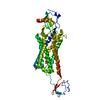 7f1tC M: map data used to model this data C: citing same article ( |
|---|---|
| Similar structure data |
- Links
Links
- Assembly
Assembly
| Deposited unit | 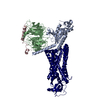
|
|---|---|
| 1 |
|
- Components
Components
| #1: Protein | Mass: 51241.047 Da / Num. of mol.: 1 / Mutation: T15R,T112C,G259N Source method: isolated from a genetically manipulated source Details: Fusion protein of MIP-1a and CCR5 / Source: (gene. exp.)  Homo sapiens (human) / Gene: CCL3, G0S19-1, MIP1A, SCYA3, CCR5, CMKBR5 / Production host: Homo sapiens (human) / Gene: CCL3, G0S19-1, MIP1A, SCYA3, CCR5, CMKBR5 / Production host:  |
|---|---|
| #2: Protein | Mass: 40447.141 Da / Num. of mol.: 1 / Mutation: S47C,G202T,G203A,E245A,A326S Source method: isolated from a genetically manipulated source Source: (gene. exp.)  Homo sapiens (human) / Gene: GNAI1 / Production host: Homo sapiens (human) / Gene: GNAI1 / Production host:  |
| #3: Protein | Mass: 37416.930 Da / Num. of mol.: 1 Source method: isolated from a genetically manipulated source Source: (gene. exp.)  Homo sapiens (human) / Gene: GNB1 / Production host: Homo sapiens (human) / Gene: GNB1 / Production host:  |
| #4: Protein | Mass: 7861.143 Da / Num. of mol.: 1 Source method: isolated from a genetically manipulated source Source: (gene. exp.)  Homo sapiens (human) / Gene: GNG2 / Production host: Homo sapiens (human) / Gene: GNG2 / Production host:  |
| Has protein modification | Y |
-Experimental details
-Experiment
| Experiment | Method: ELECTRON MICROSCOPY |
|---|---|
| EM experiment | Aggregation state: PARTICLE / 3D reconstruction method: single particle reconstruction |
- Sample preparation
Sample preparation
| Component | Name: Chemokine receptor CCR5 in complex with MIP-1a and Gi / Type: COMPLEX / Entity ID: all / Source: RECOMBINANT |
|---|---|
| Source (natural) | Organism:  Homo sapiens (human) Homo sapiens (human) |
| Source (recombinant) | Organism:  |
| Buffer solution | pH: 7.5 |
| Specimen | Embedding applied: NO / Shadowing applied: NO / Staining applied: NO / Vitrification applied: YES |
| Vitrification | Cryogen name: ETHANE |
- Electron microscopy imaging
Electron microscopy imaging
| Experimental equipment |  Model: Titan Krios / Image courtesy: FEI Company |
|---|---|
| Microscopy | Model: FEI TITAN KRIOS |
| Electron gun | Electron source:  FIELD EMISSION GUN / Accelerating voltage: 300 kV / Illumination mode: SPOT SCAN FIELD EMISSION GUN / Accelerating voltage: 300 kV / Illumination mode: SPOT SCAN |
| Electron lens | Mode: BRIGHT FIELD |
| Image recording | Electron dose: 2.1875 e/Å2 / Film or detector model: GATAN K3 BIOQUANTUM (6k x 4k) |
- Processing
Processing
| CTF correction | Type: NONE | ||||||||||||||||||||||||
|---|---|---|---|---|---|---|---|---|---|---|---|---|---|---|---|---|---|---|---|---|---|---|---|---|---|
| 3D reconstruction | Resolution: 2.9 Å / Resolution method: FSC 0.143 CUT-OFF / Num. of particles: 7095732 / Symmetry type: POINT | ||||||||||||||||||||||||
| Refinement | Stereochemistry target values: GeoStd + Monomer Library + CDL v1.2 | ||||||||||||||||||||||||
| Displacement parameters | Biso mean: 55.63 Å2 | ||||||||||||||||||||||||
| Refine LS restraints |
|
 Movie
Movie Controller
Controller





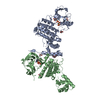
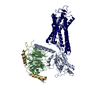
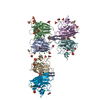
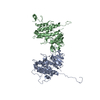


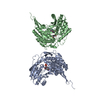
 PDBj
PDBj

































